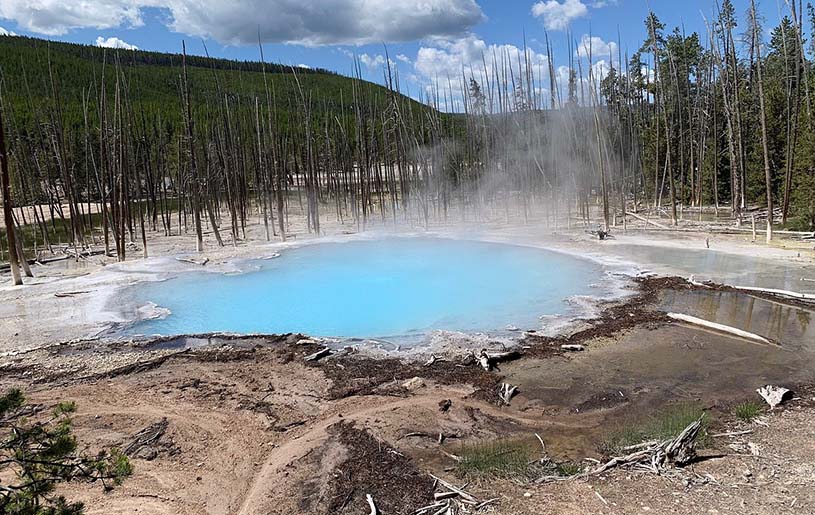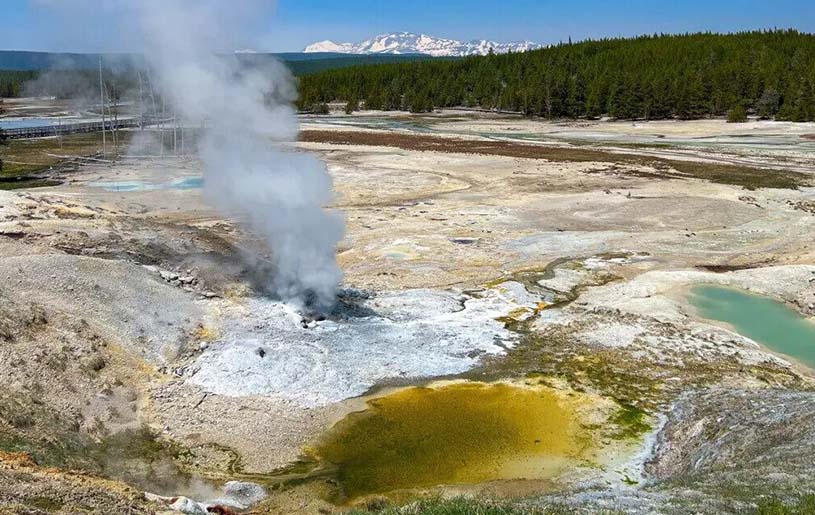Yellowstone, the world’s first national park, is renowned for its breathtaking geothermal features, diverse wildlife, and mesmerizing natural landscapes. Every year, this park draws countless visitors eager to experience its wonders firsthand. Visiting Yellowstone in August offers the perfect balance of pleasant weather and the opportunity to witness wildlife in their natural habitat. To help you make the most of your journey, I’ve compiled a comprehensive guide filled with practical advice and tips that will ensure your trip is both smooth and unforgettable.
West Thumb Geyser Basin
West Thumb Geyser Basin was the first stop on my Yellowstone adventure. Situated on the southwestern shore of Yellowstone Lake, this geothermal area is one of the highest-elevation thermal basins in the park. The vibrant hues of the hot springs here—ranging from deep blues to vivid greens and bright oranges—create a stunning natural palette. One of the most striking features is the Fishing Cone Geyser, located right on the lake’s edge, resembling a boiling pot set against the serene backdrop of Yellowstone Lake. The boardwalks around West Thumb Geyser Basin offer an easy and enjoyable hike, allowing you to take in the surreal geothermal features while feeling the cool breeze from the lake.
Upper Geyser Basin
No visit to Yellowstone would be complete without exploring the Upper Geyser Basin. This area is home to approximately 150 geysers, accounting for nearly a quarter of all the geysers on Earth. The most famous among them is the Old Faithful Geyser, renowned for its predictability. It erupts roughly every 90 minutes, sending a powerful column of water over 30 meters into the air. Watching Old Faithful in action is a must-see experience that truly showcases the raw power of nature. But the Upper Geyser Basin offers more than just Old Faithful—Castle Geyser, Giant Geyser, and Grand Geyser each boast their unique eruption patterns and colors, making this area a geothermal wonderland.
Biscuit Basin
Biscuit Basin, located just north of the Upper Geyser Basin, is a small yet dynamic geothermal area named for its unique rock formations. Here, the Sapphire Pool stands out as a gem among the thermal features, with its clear, deep blue waters resembling a giant sapphire. The basin also features Jewel Geyser and Black Opal Geyser, each contributing to the vibrant display of geothermal activity. Although smaller in scale, Biscuit Basin’s beauty lies in its concentrated array of colorful springs and geysers.
Grand Prismatic Spring
Grand Prismatic Spring is perhaps Yellowstone’s most iconic and visually stunning attraction. Located in the Midway Geyser Basin, it is the largest hot spring in the United States and the third largest in the world. The spring’s vivid rainbow-like colors—ranging from deep blue in the center to greens, yellows, oranges, and reds around the edges—are caused by thermophilic bacteria that thrive in the hot waters. Visiting in August, when the sunlight is at its peak, makes the colors even more vibrant and awe-inspiring. To fully appreciate the grandeur of Grand Prismatic Spring, I recommend taking a short hike up the nearby hill, where you can gaze down on the spring and take in its full spectrum of colors.

Norris Geyser Basin
Norris Geyser Basin is Yellowstone’s oldest, hottest, and most dynamic geothermal area. It is also home to Steamboat Geyser, the world’s tallest active geyser, which can blast water over 90 meters into the air during its rare and unpredictable eruptions. Witnessing one of these eruptions is a truly awe-inspiring experience, a reminder of the powerful forces at work beneath the Earth’s surface. The basin’s Porcelain Basin area is another highlight, with its colorful springs, steaming vents, and acidic pools creating an otherworldly landscape. The intensity and variety of geothermal activity in Norris Geyser Basin make it one of the most fascinating areas in the park.
Grand Canyon of the Yellowstone
The Grand Canyon of the Yellowstone is one of the park’s most spectacular natural features. Carved by the Yellowstone River, the canyon stretches for about 32 kilometers, with depths of over 300 meters. The canyon walls are painted in shades of red, orange, and yellow, creating a vivid contrast with the surrounding greenery. From Artist Point on the south rim, I enjoyed a breathtaking view of the entire canyon, a panorama that seemed to capture the very essence of Yellowstone’s rugged beauty. Within the canyon, the Yellowstone Falls—comprising the Upper Falls (33 meters) and the Lower Falls (94 meters)—add to the drama of the landscape, with their powerful cascades and the thunderous roar of the water.
Hayden Valley
Hayden Valley is a prime location for wildlife viewing in Yellowstone. This expansive valley is home to large herds of bison, elk, and even the occasional grizzly bear. Visiting in the early morning or late evening increases your chances of spotting these animals as they go about their daily activities. During my time in Hayden Valley, I was fortunate enough to see bison grazing peacefully and even caught sight of a few grizzly bears in the distance. The tranquility and harmony of Hayden Valley’s natural environment make it a paradise for nature lovers and photographers alike.
Mammoth Hot Springs

Mammoth Hot Springs, located near Yellowstone’s northern entrance, is renowned for its striking travertine terraces. These limestone formations have been created over thousands of years by mineral deposits left behind by hot spring water. The terraces range in color from pure white to rich orange and brown, depending on the mineral content. Walking along the boardwalks, I was mesmerized by the beauty of these natural formations, which look like a grand staircase sculpted by nature itself. The continuously changing patterns and colors of the terraces make Mammoth Hot Springs a dynamic and captivating destination.
Spotting Yellowstone Bears
Yellowstone’s wildlife is one of the park’s greatest treasures, and among the most iconic animals are the Yellowstone bears. The park is home to both grizzly bears and black bears, and August is a prime time to observe them as they prepare for winter by foraging for food. Hayden Valley and Lamar Valley are particularly good spots for bear watching. During my visit, I had the thrilling experience of seeing Yellowstone bears in their natural habitat—a sight that filled me with awe and respect for these magnificent creatures. It’s important to maintain a safe distance and never approach or feed the bears to ensure both your safety and the bears’ well-being.
Yellowstone National Park is undoubtedly a haven for nature enthusiasts. From its extraordinary geothermal features to its diverse wildlife and stunning landscapes, every corner of this park offers something unique and awe-inspiring. Visiting in August, when the weather is ideal, allows for the best possible experience of outdoor activities and wildlife viewing. Whether you’re captivated by the colorful hot springs, the majestic waterfalls, or the grandeur of the canyon, Yellowstone promises unforgettable memories at every turn. I hope this practical guide helps you plan your visit and inspires you to explore the wonders of Yellowstone National Park, a place where nature’s beauty and power are on full display.






